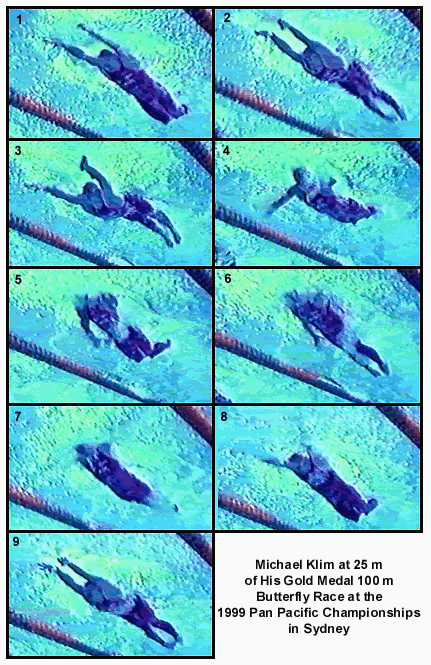HOW CHAMPIONS DO IT
Researched, produced, and prepared by Brent S. Rushall,
Ph.D., R.Psy.

MICHAEL KLIM AT 25 m OF HIS GOLD MEDAL RACE AT THE 1999 PAN PACIFIC CHAMPIONSHIPS IN SYDNEY
Michael Klim's time for this race was 52.49 seconds.
Notable Features
Frame #1: Entry occurs with the hands a good distance apart. However, with sprint butterfly, the kinetic energy derived from wide-sweeping straight arms prevents halting the arms at this width. As with other analyses of Michael Klim, the arms continue to sweep in, even after entry. It might be better to orient the arms forward at entry rather than with a strong lateral and inward force. Streamline is good in this frame with the body flat.
Frame #2: Indeed the hands have almost come together, changed direction and are now spreading apart. The inward-outward movements do nothing for propulsion. The lateral forces they create are insufficient to halt the head and shoulders from diving, which in turn produces a lifting of the hips. All these actions are unnecessary, reduce streamlining, and produce an even longer delay before propulsive forces can be generated.
Frame #3: The hands have spread, somewhat similar to an outward sculling motion often seen in breaststroke, and are now in a position where strong propulsive forces can be generated. The head and shoulders have continued their dive from that exhibited in frame #2. From here, much energy will have to be expended to lift the head and shoulders up out of the water to eventually breathe.
Frame #4: The arms are well into propulsion. This extremely powerful man is directing force backward and downward with the hand/forearm propelling surfaces and probably with the upper arms as well. Adduction of the upper arms generates the force. The magnitude of that force can be seen by the drag-force turbulence following both forearms and hands. The hips and legs have straightened to a streamlined position.
Frame #5: The arms have reached the end of adduction and have begun to extend. The length of Michael Klim's propulsive action is longer than most butterfly swimmers. The head is out of the water to facilitate breathing. The legs kick down to hold the hips up in a streamlined position.
Frame #6: The exceptional length of Michael Klim's underwater propulsive stroke is illustrated, as the arms are fully extended and still underwater. Such a long stroke facilitates the highest possible velocity at exit. The kick is completed and the hips remain near the surface while the head remains clear of the water.
Frame #7: A fast wide-sweeping rigid-arm recovery does not generate as much vertical force as some other butterfly recovery actions. Consequently, the hips drop only a relative small amount as a reaction to the arm recovery with head out of the water. At this stage, the head is being lowered back into the water to look toward the bottom. That further reduces the forces that will cause the hips to sink. The feet rise preparatory to kicking.
Frame #8: The arms are close to entering. The knees bend to initiate a kick to counterbalance both the head being lowered into the water and the arms coming down to enter.
Frame #9: A position similar to that of frame #2 is displayed.
Michael Klim has gone on to improve on this swim with his new world record that is more than half a second faster than his time here.
This critical analysis might be questioned because Klim is such a dominant 100-m butterfly swimmer. However, as Michael Klim has demonstrated over the past two years, this is an event where significant improvements in the world record are possible. Given his phenomenal physical attributes, it is possible that Michael Klim could swim much faster if some of the "inefficiencies" commented on in this analysis were eliminated.
Most of Michael Klim's "inefficiencies" stem from his rigid arm recovery. Such actions cause excessive lateral forces that are evidenced at entry. Perhaps some slight bending at the elbow in the middle of the recovery would orient more kinetic energy forward. There possibly could also be some conscious elevation of the shoulders as the arms enter to produce a reaching forward action rather than a sweeping in movement.

Return to Table of Contents for this section.




